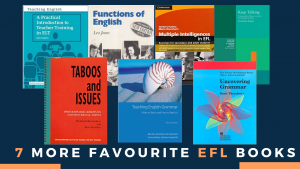TOEFL Teacher: Why Your Students Are Not Getting Higher Scores
Whatever a student’s ability, if they are unfamiliar with the strategies required to perform well at a particular examination, they will not do their best. The TOEFL is quite unlike the IELTS exam, so teachers familiar with the latter should try the test themselves, to find out what might trip the students up as they struggle to perform under stress and strict time limits. However, here are some areas where students may fail to comprehend the instructions or, most importantly, waste time.
The Speaking Test
The main challenge here is that learners have only 45 seconds to blurt out an answer to the question they are given onto an MP3 recording. This seems unnecessarily stressful. For those who would like to gather their thoughts before mentally composing an answer, the teacher would have to advise, “no!” Lots of timed practice is obviously necesary here. In reality ,there is no situation where the addressee has to comprehend a complex question and give an answer in 45 seconds. Any hesitation strategies used would have to be very quick.
A native speaker would find it challenging to answer this question well under this time pressure and test-takers will not be able to show off their English-speaking ability to the full.
The unusual nature of the task
The TOEFL Speaking Exam might also throw off the test-taker due to the unusual and inauthentic nature of the task. To quote from the ETS site: “Test takers read a short passage communicating a typical campus situation or policy and then listen to a conversation in which a speaker expresses an opinion about the situation or policy. Test takers are then asked to give an oral summary of the speaker’s opinion. A full response will require the test taker to combine and convey key information from both the reading and the listening input.”
A non-native-speaker teacher would need to analyse the sample answers provided for useful structures that could be presented and practiced in class. This is not necessarily what a non-American would describe as academic speaking or something that a high school student would have any experience of. Political analysis of university policy is not something most students elsewhere in the world concern themselves with at all in the course of their study, but the content of their courses. Speaking questions do not need to be very specialised, but would normally be expected to cover general topics of intellectual interest.
Reading and listening are important
The second task, defined as ‘Read/Listen/Speak (academic course topic)’ appears to attempt to simulate academic work, in that test-takers must listen to a lecture, read a passage, and then explain orally how the two are related. This is far more complex than the IELTS speaking exam and involves as much reading and listening as speaking. It is not necessarily a task students must perform at university, though this is possible and therefore not particularly authentic and not something test-takers might expect from a test of spoken English. So much of their performance depends on their reading and listening ability, whereas in other tests, comprehension of the examiners’ questions is very much secondary to the students’ ability to express themselves in a foreign language orally.
The Reading Test
The test examined here is the Practice Reading Set currently presented on the English Testing Service website.
Firstly, when it comes to taking the test itself, many learners will automatically read through the passage carefully before looking at the questions. This wastes valuable time, as learners would be better focused simply skimming the reading for gist very quickly, before analysing the questions carefully. They can then read with a purpose and more efficiently. After all, test-takers have only twenty minutes to read the passage and not only select answers but complete a summary of the text, which does not seem sufficient.
Question 10 in particular seems very time-consuming. Very lengthy, multi-clause sentences need to be comprehended and selected as correct summaries of the passage.
Writing in full is a waste of time
In fact, the table layout of question 10 may catch some test-takers out and confuse them into writing out the sentences in full, as they are given this option as well as the choice of simply writing the letter of the answer. The reason for leaving this option is unclear, but it does leave the way open for test-takers to spend the entire twenty minutes of the test carefully typing the answer sentences for question 10 into the table for only two marks. This would, of course, very much work against a stressed-out examinee with poor IT skills. Do emphasise the fact that writing out the answer in full would be a complete waste of time.
Focus on easier and quicker
As many learners will be unable to complete the test in twenty minutes, the teacher should encourage them to focus on those test items that are easier and quicker to answer, before attempting the more complex ones. On the plus side, the reading test is short, at only twenty minutes, where the IELTS reading examination for entrance to university in the UK or Australia takes an hour to complete and has four sections. Learners can really focus their attention.
For question one, your learners may struggle because reading to find what information is not included is an inauthentic task. By this, I mean that searching for the missing piece of information is not a skill usually performed in academic reading. Eliminating the three ideas which are included takes far longer than simply reading to find one piece of information or check the accuracy of a statement. They may also find it difficult to understand these instructions. A class to isolate this question type and practice it would really help your learners.
The most difficult question
However, perhaps the most difficult question is question nine. When test-takers reach this part of the reading test, after attempting the other questions, they find that a sentence has been removed from the introduction of the passage. The sentence is given, and the learner has to choose the correct location for it in the paragraph. This clearly affects the internal coherence of the passage and make the most crucial paragraph, the introduction, more difficult to understand. Again, this does not seem like an authentic reading task, but a writing task, such as is usually found in an exercise where students learn to construct a paragraph. As such, this may be an unexpected and confusing item for learners to encounter and should be carefully explained.
Where would the question best fit?
At first, to a fluent reader, the best way to begin this task seems to be by using knowledge of markers of cohesion as the quickest way to answer. This may seem more of a writing skill, but of course, it is an ability we use in reading as well. However, this strategy may lead to an incorrect answer, as there is more than one possible answer to this question. It is difficult to see how any student, never mind a foreign language learner, could be certain to answer this correctly. ‘Where would the sentence best fit?’ is a fairly open question. Answer D is given as correct in the key and certainly there is a logical connection between the ideas of ‘economic and religious connections with most parts of Mesoamerica,’ and the ideas of the ‘missing sentence:
In fact, artifacts and pottery from Teotihuacán have been discovered in sites as far away as the Mayan lowlands, the Guatemalan highlands, northern Mexico, and the Gulf Coast of Mexico.
However, this does not make a good concluding sentence to the essay introduction, as it does not summarise the main ideas of the rest of the article. This is usually the function of the thesis-statement, or final sentence of the introduction and helps the reader to comprehend an essay. Clearly, a test-taker has to use their knowledge of introduction structure to answer this question, but the discourse marker ‘in fact’ suggests that this sentence should fit in space A and it does also correspond to an idea extending the meaning of ‘covered at least 20 square kilometers.’
Go with your gut
Therefore, the best advice for answering this question may be to avoid the pitfall of choosing the first space that the sentence seems to fit, check all four spaces for the most appropriate and just go for whichever seems the best fit by intuition, even if you are not entirely sure. Students should be warned not to agonise over getting the right answer for too long. Perhaps there is a pattern here, that discourse markers are not particularly relevant in these reading texts. Further research needs to be done on this.
A swift answer to the question requires some awareness of central American geography, which is also needed to answer this question. Your students may have no knowledge of the location of the countries mentioned, depending on which part of the world they come from.
Question 2,
while it does test vocabulary, which is a component of reading, does not require the learner to refer to the text, although this would help if the learner does not know the word ‘ingenuity.’ Knowing this might save the learner time.
Question 3
is also testing the skill of selecting the piece of information that is not included in the passage, and so is more time-consuming than it may appear. Perhaps teachers could advise their students to gain as many marks as they can on the easier questions before they run out of time on the more complex ones.
A teacher coming to the TOEFL reading test for the first time should be very sure that they have the answer key to hand, as these multiple-choice questions require very careful reading. As has often been noted in the literature on language testing, multiple-choice questions give the test-taker the chance to answer correctly purely by chance, which hardly seems fair to those learners who might be capable of earnestly working out the answers.
Concept checking is important
However, the multiple choice format does suit students who like to coast very well. They are unlikely to be able to pass the TOEFL iBT Reading exam but will have plenty of time to disrupt your classes, having just circled any answer at random without concern. They may even be quite good at pretending to be concerned about their poor performance so that even more of the teacher’s time is wasted. Student-centred classes with plenty of concept checking could help to avoid this problem.
Grammar for the TOEFL
Another issue that teachers who have not taught the TOEFL for some time should be aware of is that the grammar exam is no longer included. This is fortunate for teachers and learners alike, as the teacher would need training in English grammar at higher degree level to be able to successfully explain the myriad advanced grammar problems that would come up in the average TOEFL grammar exercise.
Now, however, the instructor may wonder what grammar to teach. Of course, correct grammar is important in the speaking and writing exams, so it might be wise to examine these to see what language learners are required to produce. Language for reporting the opinions of others is required in several sections of the TOEFL exam, so it might be wise to provide controlled and free practice of this.
Language of comparison is clearly necessary for the writing task and it is probably up to the instructor whether to interpret this as lexical or grammatical. Both approaches might be useful.
The Writing Test
Many students fail to appreciate that examining and practicing practice test papers makes the difference. Learners certainly need to take a few practice tests before approaching the TOEFL iBT writing exam. A lot of effort has clearly been made to bring it closer to real-world academic writing, but with the effect that it is rather unusual as a writing examination. Test-takers must read a passage, listen to a lecture, and then write a short passage comparing the two.
Another potentially confusing feature of the TOEFL iBT writing exam is that the audio nature of the second text is not specified on the paper, so that learners may think they have only three minutes to read both passages and may be thrown off when the audio of the lecture is played. The only directions that are clearly given are ‘Read the transcript.’ The other part of the instructions is only given on the recording.
Use a reordering exercise
It is also difficult to focus on the content of the text, given that the topic, the willingness or unwillingness of American wood companies and consumers to pay for the eco-certification of their wood products is, firstly, very dull, being a business text that could be of interest only to people in the field, and, secondly, not presented very coherently. The teacher could compensate for this by cutting up a selection of these texts into paragraphs and asking the learners to reorganise them as a group activity. Or perhaps the introduction could be separated into individual sentences and students asked to put them in the correct order. In this way, they may get the gist of the passage in a more engaging fashion and become accustomed to this style of writing.
The Listening Test
One immediately noticeable feature of the TOEFL Listening Test is that very colloquial US English is tested. There are many websites and textbooks purporting to teach American idioms for the TOEFL test. Whether they are exhaustive or reliable is uncertain.
This is obviously favouring learners who are fully immersed in American televisual culture, rather than serious scholars. Teachers may be unaware that there are cultures and countries that do not receive the American media or are culturally prohibited from viewing it and are therefore unaware of these colloquialisms. Students and teachers alike may also not be expecting to find these idioms in what is assumed to be a test of academic English.
‘Yes’ is omitted
The justification for this is that, when the test-takers arrive in the US, they will need to understand their university tutor. Judging by the practice test given online by ETS, the tutor may say ‘Yup, that’s the idea!’ to mean, ‘that was what we intended.’ (the word ‘yes’ is omitted from the answer key, which seems inaccurate and misleading.) The teacher might like to add that this is usually an expression of exasperation and could be seen as impolite. Test-takers must complete MCQ questions for four or five informal conversations in an academic setting.
Other tests of academic English do not regard informal conversation between students or students and academic staff as worth testing in a university entrance exam and so educators and students may be unprepared.
Increase in cognitive load
First, the academic listening is catered for, as test-takers listen to three or four lectures representing different academic areas. The problem here is that each ‘lecture’ is only about five minutes long, increasing the cognitive load for students as they must get the general idea of a lecture and answer specific questions in only five minutes, before moving on to another. This is more difficult than providing one listening text of twenty minutes in length unless the topic is very familiar. It also provides less conceptual depth.
The TOEFL as an Online Examination
Many commentators have expressed concern that the online format of the TOEFL interferes with the test accuracy. A paper test would avoid the extra exam stress of any technical hitches such as screen freezes.
Any teacher knows that a technical hitch is always just around the corner to ruin the perfect lesson plan. As the test must be completed using information technology, perhaps instructors should warn students to be prepared for technical hitches and not panic. It would be good to get confirmation from your local examination centre of whether, if there is any IT problem, it just gives your students the opportunity to take the test again within the next week or so. Or are test-takers expected to just lose a few vital minutes of test time while the problem is resolved? This could cause so much stress that the student would be unable to concentrate for the remainder of the examination.
Conclusion
Overall, the extra cognitive load caused by the unusual and complicated instructions will certainly greatly disadvantage test-takers who have not taken a TOEFL preparation course, which perhaps should not be the case. The teacher will really need to concept-check that the tasks have been understood. They do at least provide ample opportunity for a bit of classroom drama, to help learners understand the nature of the communicative situations that are being tested.
Wealthier learners who holiday regularly in English-speaking countries and have easy access to the English-speaking media will also have an advantage with the listening tests’ use of colloquial US English. Students who are political animals and chatty, will benefit most from this test’s design, while those who are academically brilliant have little opportunity to shine, with the dearth of genuinely academic subject matter or depth of tasks.






